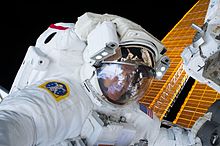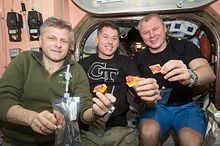Shane Kimbrough
Shane Kimbrough | |
|---|---|
 | |
| Born | Robert Shane Kimbrough June 4, 1967 Killeen, Texas, U.S. |
| Status | Active |
| Nationality | American |
| Alma mater | West Point, B.S. 1989 Georgia Tech, M.S. 1998 |
| Occupation | Army aviator |
| Space career | |
| NASA Astronaut | |
| Rank | |
Time in space | 188 days 23 hours 15 minutes |
| Selection | 2004 NASA Group 19 |
Total EVAs | 6 |
Total EVA time | 39 hours |
| Missions | STS-126, Soyuz MS-02 (Expedition 49/50), SpaceX Crew-2 |
Mission insignia | |
Robert Shane Kimbrough (born June 4, 1967) is a retired United States Army officer, and a NASA astronaut. He was part of the first group of candidates selected for NASA astronaut training following the Space Shuttle Columbia disaster. Kimbrough is a veteran of two spaceflights, the first being a Space Shuttle flight, and the second being a 6-month mission to the ISS on board a Russian Soyuz craft. He was the commander of the International Space Station for Expedition 50, and returned to Earth in April 2017. He is married to the former Robbie Lynn Nickels.[1]
Biography
Born June 4, 1967, in Killeen, Texas, Kimbrough attended The Lovett School in Atlanta, Georgia, graduating in 1985. Kimbrough graduated from the United States Military Academy in 1989 with a B.S. in aerospace engineering. He played for the West Point baseball team for 4 years, and was selected as team captain his senior year Army Black Knights baseball players. Kimbrough served as an Apache helicopter pilot in the first Gulf War, Operation Desert Storm in 1991. Kimbrough later attended and graduated from Georgia Tech with a M.S. in operations research in 1998. He helped NASA train astronauts on landing procedures for several years before he himself was selected for training.
He retired from the U.S. Army with the rank of colonel.
NASA career
STS-126

Kimbrough was a Mission Specialist on STS-126, which launched on November 14, 2008. During the mission Kimbrough performed two EVAs. On the tenth anniversary of the International Space Station, Stefanyshyn-Piper and Kimbrough successfully conducted the mission's second EVA, and Kimbrough's first, which lasted 6 hours, 45 minutes.[2] Kimbrough's second EVA was performed on November 24, 2008, and lasted 6 hours and 7 minutes. At the completion of the mission, Kimbrough's cumulative spacewalk time, was 12 hours, 52 minutes.[3]
Expedition 49/50

Kimbrough launched onboard Soyuz MS-02 to the International Space Station on October 19, 2016, as part of a four-month mission for Expedition 49/50.[4] Kimbrough became commander of Expedition 50 upon the departure of Soyuz MS-01 on October 28.[5]
On January 6, 2017, Kimbrough performed his third EVA, along with Peggy Whitson. During the EVA, they installed three new adapter plates and hooked up electrical connectors preparing the way to replace the ISS batteries. The EVA lasted 6 hours and 32 minutes.[6]

Kimbrough performed his fourth EVA with astronaut Thomas Pesquet on January 13, 2017. During the EVA, they prepared the infrastructure to replace the ISS batteries. The EVA lasted for 5 hours and 58 minutes.[7]
On March 23 2017, Kimbrough performed his fifth EVA with Thomas Pesquet. The main objective was to prepare the Pressurized Mating Adapter-3 (PMA-3) for installation of the second International Docking Adapter (IDA), which will accommodate commercial crew vehicle dockings. The EVA lasted for 6 hours and 34 minutes.[8]

On March 30, 2017 Kimbrough performed his sixth EVA with Peggy Whitson. During the EVA they connected the PMA-3 as well as installing new shields in Node 3 axial shields after losing one shield. Additionally installed another upgraded computer relay boxes on the station's truss. The EVA lasted 7 hours and 4 minutes. During this EVA Whitson became the record holder for the most EVAs for a woman (8 EVAs).[9]
Kimbrough carried a soccer ball recovered from the wreckage of the Space Shuttle Challenger to the ISS, after which it was returned to the family of Challenger astronaut Ellison Onizuka and put on display at Clear Lake High School in Houston. [10]
SpaceX Crew-2
In July 2020, NASA announced that Kimbrough will fly to space for the third time on SpaceX Crew-2 along with NASA astronaut Megan McArthur, JAXA astronaut Akihiko Hoshide, and ESA astronaut Thomas Pesquet.[11][12][13]
References
- ^ [1]
- ^ William Harwood for CBS News (2008). "Spacewalk No. 2 ends". Spaceflightnow.com. Retrieved 20 November 2008.
- ^ William Harwood (November 24, 2008). "Spacewalk No. 4 ends". Spaceflightnow.com. Retrieved November 24, 2008.
- ^ "Future Expeditions". NASA. Retrieved 6 September 2016.
- ^ "'Golden' expedition: 50th commander takes charge of space station". collectspace.com. 28 October 2016. Retrieved 22 November 2016.
- ^ "Whitson Becomes World's Oldest Female Spacewalker, as EVA-38 Replaces Aging Space Station Batteries". January 6, 2017. Retrieved January 10, 2017.
- ^ "Second Spacewalk of 2017 Successfully Complete". NASA. January 13, 2017. Retrieved January 28, 2017.
- ^ "Astronauts carry out first of three station spacewalks". CBS news. March 24, 2017. Retrieved March 28, 2017.
- ^ Garcia, Mark (March 30, 2017). "Peggy Whitson Breaks Spacewalking Record". NASA.
- ^ Malinowski, Tonya (2018). "NASA astronaut Ellison Onizuka's soccer ball that survived the Challenger explosion". ESPN.com. ESPN. Retrieved July 4, 2018.
- ^ "JAXA星出彰彦宇宙飛行士の国際宇宙ステーション(ISS)長期滞在 搭乗機決定について". JAXA. 28 July 2020. Retrieved 28 July 2020.
- ^ "Thomas Pesquet first ESA astronaut to ride a Dragon to space". ESA Science & Exploration. 28 July 2020.
- ^ Potter, Sean (28 July 2020). "NASA Announces Astronauts to Fly on SpaceX Crew-2 Mission to Space Station". NASA. Retrieved 28 July 2020.
External links
- 1967 births
- Living people
- American astronauts
- United States Army astronauts
- People from Killeen, Texas
- United States Military Academy alumni
- American Master Army Aviators
- United States Military Academy faculty
- Georgia Tech alumni
- United States Army colonels
- American army personnel of the Gulf War
- Commanders of the International Space Station
- The Lovett School alumni
- Space Shuttle program astronauts
